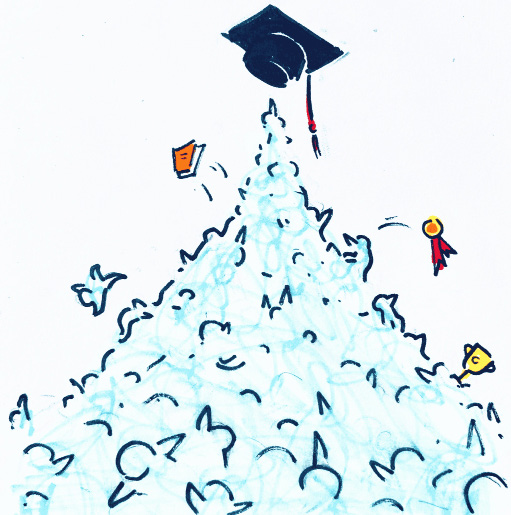Tate Collins ’27
It’s no surprise that a recent poll by Pew Research found that 75% of Americans are against legacy admissions to college. Utilized by many institutions, legacy admissions is the unjust practice of favoring applicants who have familial ties to alums. It is an actively discriminatory and aristocratic practice that favors the rich and undermines hard-working minority applicants, opposing America’s greatest ideals: liberty, equality, and justice for all.
At the core of America’s identity as a nation is the American Dream: the idea that all Americans are equally entitled to the opportunity to succeed through hard work. The very principles of legacy admissions directly contradict this core American value. Favoring applicants based on hereditary privilege, rather than academic achievement, is inconsistent with the American commitment to equality. Yet the practice remains incredibly ubiquitous at elite institutions.
In the post-affirmative action era, it is becoming increasingly difficult for universities to maintain diversity in their student bodies. Since the Supreme Court ruling prohibiting race-conscious admissions, elite institutions like MIT have reported as much as an 8% drop in Black and African American admissions.
Without affirmative action to facilitate diversity at the collegiate level, universities will need other policies to enroll students from underrepresented communities. Legacy admissions only further hinder schools’ abilities to recruit these candidates.
While diversity among legacies has improved in recent years, there is still a long way to go. Former Chief Counsel at Lawyers’ Committee for Civil Rights, John Britain, along with Attorney Eric Bloom, determined that underrepresented minorities comprise a measly 6.7% of legacy applicants. This is in stark contrast to the 12.5% that the group represents in the entire applicant pool. Despite an increase in diversity among legacy applicants, they are still disproportionately affluent and white. Prioritizing this applicant group goes directly against the principles of equality that our country and many of the education institutions within it praise.
Universities often cite raising funds as an excuse for preserving legacy admissions. However, this reasoning lacks grounding in evidence. Recent research suggests that no significant correlation exists between legacy admissions at an institution and increased donations. In a study examining the top 100 national universities from 1998 through 2007, Chad Coffman of Winnemac Consulting and his co-authors found “no evidence that legacy-preference policies themselves exert an influence on giving behavior.” This research group investigated several universities that had eliminated legacy preferences during this period. They concluded there was “no short-term measurable reduction in alumni giving as a result of abolishing legacy preferences.” The groundlessness of the donations argument undermines universities’ number one excuse for preserving legacy admissions.
A month ago, California took the massive step of banning legacy admissions in all universities, both public and private, in the state. Of the decision, Governor Gavin Newsom stated, “In California, everyone should be able to get ahead through merit, skill, and hard work.”
The ability to “get ahead” should be available to all Americans, not just those applying to California schools. It’s time every university follows California’s lead and ends the unjust and aristocratic practice of legacy admissions.
Jeremy Fang ’28
It’s easy to dismiss legacy admissions as unfair. Public sentiment sometimes frames this tradition as an archaic remnant of an elitist past—a barrier to a college process that rewards merit instead of deep-pocketed donors.
But after looking a little deeper, I’ve come to recognize an inconvenient truth: legacy admissions are a necessary evil. A 2022 study by Ethan Poskanzer, assistant professor at the Leeds School of Business at U.C. Boulder, and Emilio Castilla, professor at MIT’s Sloan School of Management, found that universities have a variety of good reasons for preferring students whose relatives attended the school.
First, legacy recruits are far more likely to enroll if admitted. This allows schools to more accurately predict yield—that is, the ratio of students admitted to those who attend. It reflects poorly on a school if a large percentage of admits choose to enroll elsewhere; legacy admissions help guarantee that a higher proportion of a university’s admits will choose to attend.
Second, legacy admissions are key to the operation of elite universities. Most private colleges depend on donations to keep their doors open. For proof, let’s look at a school we all know: Harvard University. According to information from the Harvard Financial Administration, donations contribute more than twice as much to Harvard’s revenue as tuition. Gifts from alumni constitute a very large percentage of these donations, and as such, are a crucial source of funding for the school. This money is used to pay teachers competitive wages, thus ensuring that students receive the best education possible; it funds financial aid and scholarships, giving applicants from low-income backgrounds equal access to career opportunities (70% of Harvard students are on some form of financial aid, and the average total grant for need-based scholarships—which 55% of students receive—is over $50,000); and it is, of course, invested in electricity, housing, food, and books.
Legacy admissions are critical to incentivizing these donations: if alums believe that giving money to their alma mater will increase their child’s chances of admission, they will be more inclined to donate.
Another frequent complaint about the preferential treatment received by legacy candidates is that it disproportionately advantages white students. While currently true, this problem isn’t inherent in legacy admissions—instead, it is a product of who currently has legacy status. The Ivies of generations past lacked virtually any racial diversity; in 1980, white students accounted for approximately 80% of Yale’s student body. But as admissions departments focus more and more on recruiting candidates from underrepresented populations, that number has fallen to below 50%. Any racial inequities that are advanced by legacy admission will thus fade over time: in 30 years, the applicants benefitting from this policy will be just as diverse as our college campuses today.
The most devoted anti-legacy proponents claim that legacy admits take spots from qualified underprivileged applicants. However, the archetype of a snotty trust fund kid stealing the acceptance of a deserving, first-generation applicant is fundamentally incorrect. In most cases, legacy status only comes into play when considering two equally privileged applicants— the one who gets rejected will simply attend some other wonderful college.
It’s time for people to stop overreacting and come to terms with the facts: all in all, legacy admissions are pretty good.






